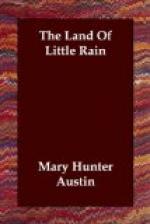The river canons of the Sierras of the Snows are better worth while than most Broadways, though the choice of them is like the choice of streets, not very well determined by their names. There is always an amount of local history to be read in the names of mountain highways where one touches the successive waves of occupation or discovery, as in the old villages where the neighborhoods are not built but grow. Here you have the Spanish Californian in Cero Gordo and pinon; Symmes and Shepherd, pioneers both; Tunawai, probably Shoshone; Oak Creek, Kearsarge,—easy to fix the date of that christening,—Tinpah, Paiute that; Mist Canon and Paddy Jack’s. The streets of the west Sierras sloping toward the San Joaquin are long and winding, but from the east, my country, a day’s ride carries one to the lake regions. The next day reaches the passes of the high divide, but whether one gets passage depends a little on how many have gone that road before, and much on one’s own powers. The passes are steep and windy ridges, though not the highest. By two and three thousand feet the snow-caps overtop them. It is even possible to win through the Sierras without having passed above timber-line, but one misses a great exhilaration.
The shape of a new mountain is roughly pyramidal, running out into long shark-finned ridges that interfere and merge into other thunder-splintered sierras. You get the saw-tooth effect from a distance, but the near-by granite bulk glitters with the terrible keen polish of old glacial ages. I say terrible; so it seems. When those glossy domes swim into the alpenglow, wet after rain, you conceive how long and imperturbable are the purposes of God.
Never believe what you are told, that midsummer is the best time to go up the streets of the mountain—well—perhaps for the merely idle or sportsmanly or scientific; but for seeing and understanding, the best time is when you have the longest leave to stay. And here is a hint if you would attempt the stateliest approaches; travel light, and as much as possible live off the land. Mulligatawny soup and tinned lobster will not bring you the favor of the woodlanders.
Every canon commends itself for some particular pleasantness; this for pines, another for trout, one for pure bleak beauty of granite buttresses, one for its far-flung irised falls; and as I say, though some are easier going, leads each to the cloud shouldering citadel. First, near the canon mouth you get the low-heading full-branched, one-leaf pines. That is the sort of tree to know at sight, for the globose, resin-dripping cones have palatable, nourishing kernels, the main harvest of the Paiutes. That perhaps accounts for their growing accommodatingly below the limit of deep snows, grouped sombrely on the valley-ward slopes. The real procession of the pines begins in the rifts with the long-leafed Pinus Jeffreyi, sighing its soul away upon the wind. And it ought not to sigh in such good company. Here begins




